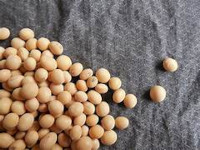The Enhancement of Isoflavone Aglycones Daidzein and Genistein from Soybean Devon-1 Tempeh through Heat Treatment after 61 Hours of Fermentation http://www.doi.org/10.26538/tjnpr/v7i12.35
Main Article Content
Abstract
Daidzein and genistein, the main isoflavone aglycone in soybean, are significantly gaining attention due to the numerous health benefits. Devon-1 variety of soybean, found in Indonesia, has the highest total isoflavone content. However, the compound predominantly exists in glycoside form, requiring hydrolysis during tempeh fermentation to obtain bioactive aglycone. Previous investigations indicated that ethanol extract of Devon-1 soybean after 61 hours showed lower daidzein and genistein levels compared to 1 N HCl hydrolyzed soybean. Therefore, this study aimed to enhance daidzein and genistein contents through heat treatment of Devon-1 soybean tempeh after 61 hours of fermentation. The sample was heated using a dry oven at 40, 50, and 60°C for 2 hours and extracted with ultrasonic bath with ethyl acetate solvent and 100% amplitude for 10 mins. Extract was analyzed using RP-HPLC with UV/Vis detector at 265 nm, methanol, and 0.1% acetic acid (47:53) as mobile phase. The results showed a 2-3 times increase in daidzein and genistein levels after heat treatment in all temperatures, particularly at 40°C. This suggested that heat treatment was a viable means to enhance the main isoflavone in tempeh.
Downloads
Article Details

This work is licensed under a Creative Commons Attribution-NonCommercial-NoDerivatives 4.0 International License.
References
Duchnik E, Kruk J, Baranowska-Bosiacka I, Pilutin A, Maleszka R, Marchlewicz M. Effects of the soy isoflavones, genistein and daidzein, on male rats’ skin. Adv Dermatol Allergol. 2019; 36(6):760–766.
Wisudanti DD, Normasari R, Hidayati T. Hepatoprotective effects of soy flour (Glycine max (L.) Merr.) supplementation in diazinon-treated wistar rats. Trop J. Nat Prod Res. 2021; 5(2):233-237.
Krisnawati A. Soybean as source of functional food. Iptek Tanaman Pangan. 2017; 12(1):57–65.
Hasanah SU, Sukrasno, Hartati R, W DP. Comparison of genistein content on some Indonesian soybean varieties. J. Penelit. Pertanian Tanaman Pangan. 2020; 4(2):113–118.
Sulistyowati E, Martono S, Riyanto S, Lukitaningsing E. Analysis of daidzein and genistein in soybeans (Glycine max L. Merrill) varieties anjasmoro, argomulyo and dena 2 using the HPLC method. Media Farmasi Indonesia. 2018; 13(1):1299–1304.
Ministry of Agriculture. Description of soybean variety Detap 1. Attachment to the Decree of the Minister of Agriculture of the Republic of Indonesia No. 340/KPTS/TP.030/5/2017 about Release of the Soybean Harapan Strain G 511 H /Anjasmoro-1-2 as a Superior Variety with the name Detap 1. Indonesia: Ministry of Agriculture; 2017. 1-2 p.
Fahmi R, Khodaiyan F, Pourahmad R, Emam-Djomeh Z. Effect of ultrasound assisted extraction upon the genistin and daidzin contents of resultant soymilk. J Food Sci Technol. 2014; 51(10):2857–2861.
Kazlauskaite JA, Ivanauskas L, Bernatoniene J. Novel extraction method using excipients to enhance yield of genistein and daidzein in Trifolium pratensis L. Pharmaceutics. 2021; 13(6):1–17.
Charpe TW, Rathod VK. Effect of ethanol concentration in ultrasound assisted extraction of glycyrrhizic acid from Licorice root. Iran. J. Chem. Eng. 2014; 11(4):21–30.
Nemitz MC, Fachel FNS, Beckenkamp A, Buffon A, Teixeira HF, von Poser GL. Soybeans isoflavone aglycone-rich extracts: Optimization by different bioprocesses and production of a purified fraction with promising wound healing property. Ind Crops Prod. 2017; 105:193–202.
Kameda T, Aoki H, Yanaka N, Kumrungsee T, Kato N. Production of isoflavone aglycone-enriched tempeh with Rhizopus stolonifer. Food Sci. Technol. Res. 2018; 24(3):493–499.
Hasanah SU, Sukrasno, Hartati R, W DP. Effect of tempe processing on genistein content. J. Pharm. and Biol. 2023; 1(1):23–29.
Lee JH, Choung MG. Determination of optimal acid hydrolysis time of soybean isoflavones using drying oven and microwave assisted methods. Food Chem. 2011; 129(2):577–582.
National Standardization Agency of Indonesia (BSN). Tempeh: Indonesia's Offering to the World. Indonesia: BSN; 2012. 1-17 p.
Blicharski T, Oniszczuk A. Extraction methods for the isolation of isoflavonoids from plant material. Open Chem. 2017; 15(1):34–45.
Oroian M, Ursachi F, Dranca F. Influence of ultrasonic amplitude, temperature, time and solvent concentration on bioactive compounds extraction from propolis. Ultrason. Sonochem. 2020; 64:1–10.
Singh A, Nair GR, Liplap P, Gariepy Y, Orsat V, Raghavan V. Effect of dielectric properties of a solvent-water mixture used in microwave-assisted extraction of antioxidants from potato peels. Antioxidants. 2014; 3(1):99–113.
Hornig A, Lorbeer E, Vollmann J. Isoflavone concentration of soybean in Central Europe as determined by HPLC/UV analysis before and after acid hydrolysis. Acta Aliment. 2011; 40(2):247–253.
Wang M, Guo J, Qi W, Su R, He Z. An effective and green method for the extraction and purification of aglycone isoflavones from soybean. Food Sci. Biotechnol. 2013; 22(3):705–712.
Dwiatmaka Y, Yuniarti N, Lukitaningsih E, Wahyuono S. Fermentation of soybean seeds using Rhizopus oligosporus for tempeh production and standardization based on isoflavones content. Int. J. Appl. Pharm. 2022; 14(6):131–136.
Ferreira MP, de Oliveira MCN, Mandarino JMG, da Silva JB, Ida EI, Carrão-Panizzi MC. Changes in the isoflavone profile and in the chemical composition of tempeh during processing and refrigeration. Pesqui Agropecu Bras. 2011; 46(11):1555–1561.
Teegarden M. Heat treatment of soy flour and its effects on β-glucosidase activity [PhD Thesis]. United States: The Ohio State University; 2012. 3-11 p.
Qin Y, Li Q, Luo F, Fu Y, He H. One-step purification of two novel thermotolerant β-1,4-glucosidases from a newly isolated strain of Fusarium chlamydosporum HML278 and their characterization. AMB Express. 2020; 10(182):1-11.


